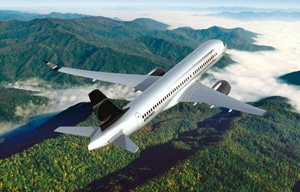August 2, 2010

Metalsproducers are fighting hard to regain market share in the aircraft businessfollowing the success of carbon-reinforced composites in the Boeing 787 Dreamliner.
One of thebiggest developments comes from Alcan Engineered Products, which is introducing a newlightweight alloy that combines aluminum, copper, lithium, magnesium and silveralloy. Called AIRWARE(TM), the new alloy is said to exhibit high strength, hightoughness and high corrosion resistance. According to Alcan, the new alloy alsofeatures high crack extension before unstable fracture of wide pre-crackedpanels.
Alcan, aunit of Rio Tinto, rolled out the new alloy at the Farnsborough Air Show inEngland, where Boeing also flew the Dreamliner across the Atlantic Ocean for thefirst time.
Alcan GlobalATI and Bombardier, a large aircraft manufacturer based in Quebec, have enteredinto a long-term agreement for the exclusive supply of AIRWARE to provideprimary structure for the new CSeries aircraft. AIRWARE will comprise more than20 percent of all materials used in the CSeries, which is now in the DetailedDesign Phase (DDP).
Aircraft Materials' Battle Heats up_A |
Bombardierhas begun releasing design datasets (drawings) to fabrication and productionfor the first ground and flight test aircraft. The aircraft is expected tocommercially debut in 2013.
Built in China
Thealuminum-lithium fuselage test barrel was built in China and has alreadysuccessfully completed 60,000 fatigue cycles. The production fuselage for theCSeries will be built in Shenyang, China by Shenyang Aircraft Corp. (SAC), asubsidiary of the state-owned China Aviation Industry Corp. (AVIC).
Bombardiersays the CSeries is the only modern aircraft specifically designed for the 100-to 149-seat market segment, and is already racking up significant orders.
Since theCSeries aircraft program was announced in 2008, Bombardier has received ordersfrom Deutsche Lufthansa, Lease Corp. International and Republic Airways for atotal of 33 CS100 and 57 CS300 aircraft. Options have been placed on a total of90 additional CSeries aircraft.
Thanks tothe use of the new-age aluminum, the pitch for the CSeries sounds a lot likethe pitch for the Dreamliner: The aircraft will emit 20 percent less carbondioxide and 50 percent less nitrogen oxide, fly four times quieter, and deliversignificant energy savings - 20-percent fuel burn advantage, as well as 15-percentimproved cash operating costs versus current in-production aircraft of similarsize.
AIRWARE mayhave one significant advantage over carbon composites: recyclability ofmanufacturing waste.
Aircraft Materials' Battle Heats up_B |
Is it Recyclable?
According toAlcan, material removed during machining can be "infinitely" recycled into newaircraft parts, as can all components when an aircraft reaches the end of itscommercial life. Boeing says it is working to develop commercial recyclingprocesses for its composite waste, both for economic and environmental reasons.
Aluminum isnot the only metal technology in greater play for aircraft applications.
AlleghenyTechnologies Inc. introduced its new titanium ATI 425(R) Alloy to thecommercial aerospace industry at this year's Farnborough International Air Show.
The titaniumalloy's elements produce a material that can be hot or cold rolled and annealedto produce sheet with strength comparable to conventional pack-rolled titanium6-4 sheet, but with improved formability due to higher room-temperatureductility.
ATI saysthat ATI 425 Alloy sheet can be produced with superior gauge control andimproved surface finish, offering aircraft designers new opportunities forimproving manufacturability and weight-saving potential.
A newmagnesium technology also has promise. Sheet made in aliquid-forming process is said to provide 200 percent higher strength andimproved toughness compared to conventional magnesium, while also providing thestrength of carbon steel sheet at one-fourth the weight.
New Fasteners
Alcoa isdeveloping new aluminum fasteners which have played a major role in theDreamliner assembly, and is working on advanced hybrid structures at its technical center nearPittsburgh. Since Boeing launched the 787, Alcoa has developed threegenerations of aluminum lithium alloys.
"A fewyears ago, the industry consensus was that composites were the default materialof choice," says Dan Goodman, director of marketing, Alcoa Aerospace. "That isno longer the case - particularly for narrow body aircraft. At a substantiallyreduced risk, proprietary aluminum alloys and new aluminum-lithium alloys offerimprovements in weight savings and enhanced strength at a lower cost."
Alcoa andCommercial Aircraft Corp. of China are jointly exploring advanced aluminumstructural concepts, designs and alloys to create a 190-seat aircraft, theC919. The aircraft will be assembled in Shanghai, but will source parts andcomponents globally.
"The C919will be the largest passenger jet to be produced in China," says Wu Guanghui,chief designer of the C919 program "Our goal is to design an efficient,high-performance structure that will compete in the global aerospace market."The C919 is expected to take its first flight in 2014 and enter service in2016.
One of theoutcomes of stress test issues with the composite wing on theDreamliner was a decision by Mitsubishi Aircraft Corp. to switch from acomposite to an aluminum wing on its the MRJ-21 regional jet. After weeks ofdelays and new design development, Boeing cleared the Dreamliner for flight.
Aluminumproponents such as Goodman also point to Lockheed Martin's choice ofaluminum-lithium on the primary structures of the Orion spacecraft.
About the Author(s)
You May Also Like







